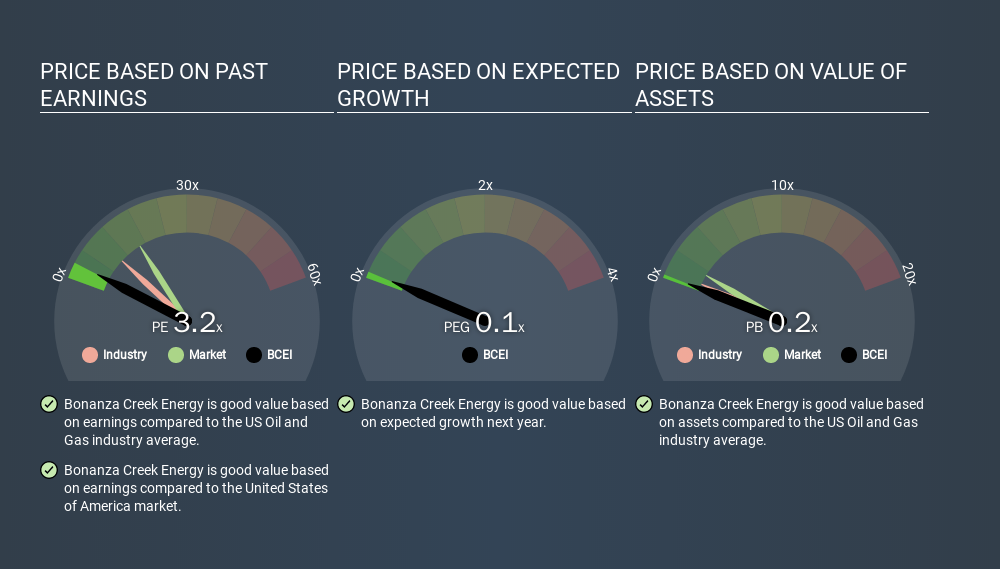Stock Analysis
- United States
- /
- Oil and Gas
- /
- NYSE:CIVI
A Sliding Share Price Has Us Looking At Bonanza Creek Energy, Inc.'s (NYSE:BCEI) P/E Ratio

Unfortunately for some shareholders, the Bonanza Creek Energy (NYSE:BCEI) share price has dived 45% in the last thirty days. That drop has capped off a tough year for shareholders, with the share price down 52% in that time.
All else being equal, a share price drop should make a stock more attractive to potential investors. In the long term, share prices tend to follow earnings per share, but in the short term prices bounce around in response to short term factors (which are not always obvious). So, on certain occasions, long term focussed investors try to take advantage of pessimistic expectations to buy shares at a better price. One way to gauge market expectations of a stock is to look at its Price to Earnings Ratio (PE Ratio). A high P/E implies that investors have high expectations of what a company can achieve compared to a company with a low P/E ratio.
Check out our latest analysis for Bonanza Creek Energy
Does Bonanza Creek Energy Have A Relatively High Or Low P/E For Its Industry?
Bonanza Creek Energy's P/E of 3.20 indicates relatively low sentiment towards the stock. We can see in the image below that the average P/E (7.5) for companies in the oil and gas industry is higher than Bonanza Creek Energy's P/E.

Bonanza Creek Energy's P/E tells us that market participants think it will not fare as well as its peers in the same industry. Since the market seems unimpressed with Bonanza Creek Energy, it's quite possible it could surprise on the upside. It is arguably worth checking if insiders are buying shares, because that might imply they believe the stock is undervalued.
How Growth Rates Impact P/E Ratios
P/E ratios primarily reflect market expectations around earnings growth rates. Earnings growth means that in the future the 'E' will be higher. That means unless the share price increases, the P/E will reduce in a few years. And as that P/E ratio drops, the company will look cheap, unless its share price increases.
Bonanza Creek Energy's earnings per share fell by 60% in the last twelve months. And EPS is down 41% a year, over the last 5 years. This growth rate might warrant a below average P/E ratio.
Don't Forget: The P/E Does Not Account For Debt or Bank Deposits
The 'Price' in P/E reflects the market capitalization of the company. So it won't reflect the advantage of cash, or disadvantage of debt. Theoretically, a business can improve its earnings (and produce a lower P/E in the future) by investing in growth. That means taking on debt (or spending its cash).
Spending on growth might be good or bad a few years later, but the point is that the P/E ratio does not account for the option (or lack thereof).
Bonanza Creek Energy's Balance Sheet
Net debt is 32% of Bonanza Creek Energy's market cap. While that's enough to warrant consideration, it doesn't really concern us.
The Verdict On Bonanza Creek Energy's P/E Ratio
Bonanza Creek Energy's P/E is 3.2 which is below average (15.1) in the US market. Since it only carries a modest debt load, it's likely the low expectations implied by the P/E ratio arise from the lack of recent earnings growth. Given Bonanza Creek Energy's P/E ratio has declined from 5.9 to 3.2 in the last month, we know for sure that the market is more worried about the business today, than it was back then. For those who prefer to invest with the flow of momentum, that might be a bad sign, but for deep value investors this stock might justify some research.
When the market is wrong about a stock, it gives savvy investors an opportunity. If it is underestimating a company, investors can make money by buying and holding the shares until the market corrects itself. So this free report on the analyst consensus forecasts could help you make a master move on this stock.
But note: Bonanza Creek Energy may not be the best stock to buy. So take a peek at this free list of interesting companies with strong recent earnings growth (and a P/E ratio below 20).
If you spot an error that warrants correction, please contact the editor at editorial-team@simplywallst.com. This article by Simply Wall St is general in nature. It does not constitute a recommendation to buy or sell any stock, and does not take account of your objectives, or your financial situation. Simply Wall St has no position in the stocks mentioned.
We aim to bring you long-term focused research analysis driven by fundamental data. Note that our analysis may not factor in the latest price-sensitive company announcements or qualitative material. Thank you for reading.
About NYSE:CIVI
Civitas Resources
An exploration and production company, focuses on the acquisition, development, and production of oil and natural gas in the Rocky Mountain region, primarily in the Field of the Denver-Julesburg Basin of Colorado.
Very undervalued average dividend payer.

